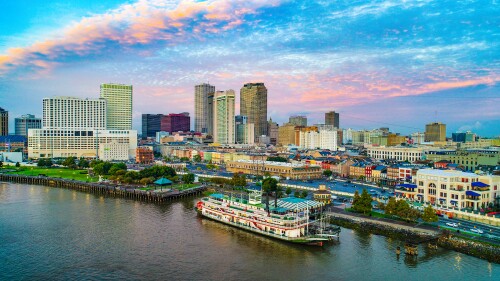“From day one, the Biden administration named racial equity and the climate crisis as immediate priorities,” said moderator Lawrence D. Frank, professor of urban studies and planning at the University of California, San Diego, and president of Urban Design 4 Health Inc. “These issues are related and often intersecting.”
Frank’s remarks came as he introduced the “Advancing Climate Resilience and Equity through Community Development and Infrastructure” panel on day two of the 2022 ULI Spring Meeting in San Diego, with representatives from four federal agencies describing the financing opportunities their agencies offer.
Frank’s recent work includes creating new equity-based walkability metrics for the Robert Wood Johnson Foundation. “Walkability doesn’t perform well for someone who is disadvantaged because it comes with more air pollution and noise and less green space or other amenities and benefits that people who are more fortunate get.” He described a number of tools he is developing that help analyze the connections between health and the equity impacts of transportation investment and land use options.
Eric Byous, brownfields project manager for the U.S. Environmental Protection Agency (EPA), Pacific Southwest region, described how the EPA’s brownfields program supports community development, including identifying redevelopment sites, conducting community outreach and visioning, planning cleanup, purchasing environmental insurance, and identifying potential funding sources. “One dollar spent in our program has been shown over time to pull in $20 from other sources for the community, so we want public/private partnerships, we want our funding to inspire other investments.” He noted that the Bipartisan Infrastructure Law has significantly increased the program’s funding: “$1.5 billion came into our program over the next five years. That’s anywhere from a four- to a sevenfold increase annually for the program.”
Seema Thomas, deputy director of Section 108 for the U.S. Department of Housing and Urban Development, described how the Section 108 loan guarantee program can be used to incorporate resilience and equity into community development and infrastructure projects. “For about every dollar of Section 108 financing, communities have been able to leverage almost $5 of additional funds,” Thomas said. “It uses the chassis of the Community [Development] Block Grant Program—annual grants that go out to states, cities, and counties to help develop viable urban communities, housing, and a suitable living environment along with economic opportunities for low- and moderate-income persons.”
Frances Sakaguchi, economic development integrator for the U.S. Department of Commerce’s Economic Development Administration (EDA), spoke about the EDA’s grant programs, which focus on fostering job creation and attracting private investment and economic capacity building. Equity is the key priority for projects EDA invests in, followed by environmentally sustainable development. “We are a small agency,” she said, “but we are a very flexible agency, in that we can support economic development in a variety of ways across multiple sectors. We don’t have the larger funds that the other agencies do, but we can do quite a bit, helping and working with other agencies to be more impactful for these communities.”
The Build America Bureau is the financing arm of the U.S. Department of Transportation, said Robert Hanifin, transportation planner for that department. “We have the TIFIA [Transportation Infrastructure Finance and Innovation Act] and RRIF [Railroad Rehabilitation and Improvement Financing] programs, with $100 billion in lending capacity, and there’s an eagerness to lend that money.”
Transportation infrastructure is often not well integrated into the community, Hanifin said, either physically or in terms of the ways communities use spaces socially, but that is changing. “We are seeing some communities in our pipeline getting really creative about combining traditional transportation projects with other types of economic development projects,” he said.
RON NYREN is a freelance architecture, urban planning, and real estate writer based in the San Francisco Bay area.





![20250517 PW - SAC Health - 02 web[1].jpg](https://cdn-ul.uli.org/dims4/default/43570aa/2147483647/strip/true/crop/2500x1405+0+130/resize/500x281!/quality/90/?url=https%3A%2F%2Fk2-prod-uli.s3.us-east-1.amazonaws.com%2Fbrightspot%2F07%2F06%2F6a84cb3148b78f5e1c660a2877a9%2F20250517-pw-sac-health-02-web1.jpg)